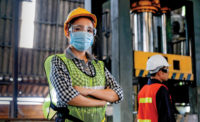Roofing Safety
The Digital Revolution in Roofing Safety Checklists
Paper-based safety checklists create several challenges in the digital age, including real-time access and overall efficiency.

Joe Graham of Collis Roofing shows a customer an EagleView aerial measurement report on his iPad.
In the fast-paced world of construction, where safety always takes the front seat, the rise of digital technology has brought about a whole new level of efficiency and accuracy. As we learn more about how technology is shaking up safety practices in roofing projects, we'll be looking closely at how cutting-edge digital tools are changing the game, helping professionals spot dangers in real time, make smart choices, and create safer and more successful roofing projects.
Traditional Safety Checklists in Roofing
In the past, safety checklists for roofing projects were primarily paper-based. Workers used physical forms to record safety inspections, hazard assessments, and equipment checks. However, this manual approach was time-consuming and prone to errors. Workers had to carry stacks of forms, and supervisors faced challenges in organizing and analyzing the collected data.
Despite their prevalence, paper-based checklists had significant limitations. They were vulnerable to loss, damage, or misplacement, leading to incomplete safety records. Additionally, the lack of real-time accessibility hindered swift responses to emerging safety issues. In large roofing projects, supervisors were overwhelmed by paperwork, diverting focus from critical safety oversight. The inflexibility of paper forms made it difficult to update safety protocols promptly, lagging behind industry standards.
Collecting and analyzing data from paper-based checklists was a laborious process. Manual transcription into spreadsheets or databases introduced errors and inconsistencies. Extracting meaningful insights from fragmented data was challenging, hampering decision-making and improvement efforts. The absence of standardized data formats made cross-project analysis and benchmarking time-consuming. Overall, these inefficiencies hindered the proactive resolution of recurring safety concerns.
The Rise of Digital Solutions
The construction industry's adoption of technology has resulted in the rise of digital safety checklist applications tailored for roofing projects. These applications mark a shift from manual paper-based processes to efficient real-time data management solutions. With user-friendly interfaces and customizable features, these tools have revolutionized the way safety checklists are conducted and managed.
Real-time Data Capture: Digital safety checklist applications offer the advantage of capturing data in real-time. As workers complete checklists on their smartphones or tablets, the data is instantly sent to a centralized database. This real-time data capture empowers supervisors and safety managers to monitor ongoing activities, identify potential risks, and take proactive measures to address hazards promptly.
Enhanced Accuracy and Consistency: Digital solutions eliminate the risk of manual transcription errors often associated with paper-based processes. The data entered into the application is accurate and consistent, ensuring the reliability of safety records for analysis and reporting. This accuracy boosts the credibility of safety documentation and supports well-informed decision-making.
Improved Team Communication: Digital safety checklist applications facilitate seamless communication within project teams. Workers can raise safety concerns, report incidents, and request guidance directly through the application. Supervisors can respond promptly, fostering a culture of open communication and swift issue resolution. This real-time interaction promotes collaboration and ensures that safety is a shared responsibility.
Efficient Compliance Tracking: Ensuring compliance with safety regulations and industry standards is crucial in roofing projects. Digital safety checklist applications simplify compliance tracking by automating reminders, notifications, and documentation. Supervisors can monitor adherence to safety protocols and promptly address deviations, thereby reducing the risk of regulatory penalties and project delays.
Key Features
Cloud-Based Accessibility:
Digital safety checklist platforms utilize cloud-based technology to enhance accessibility and collaboration. Cloud storage enables centralized data storage and retrieval, allowing authorized stakeholders to access safety records from anywhere with an internet connection. This is particularly beneficial for roofing projects involving multiple locations or remote teams.
Customization for Specific Projects:
An essential aspect of effective digital safety checklist platforms is their ability to adapt to specific roofing projects. These platforms often offer customizable templates that can be tailored to the unique requirements of each project. Customization covers various aspects, including different types of roofing materials and specific safety protocols. This ensures that safety checklists remain relevant and aligned with project goals.
Integration with Wearable Technology:
The integration of wearable technology, such as smart helmets and vests, has significantly transformed safety practices in roofing projects. These wearables are equipped with sensors and communication capabilities that enhance real-time monitoring of workers' conditions and activities. They can detect potential falls, monitor vital signs, and provide instant alerts in emergency situations.
Wearable technology also contributes to data collection by automatically recording relevant information without manual input. This integration improves the accuracy of safety data and supports proactive decision-making based on real-time insights.
Photo and Video Documentation:
Digital safety checklist platforms often offer the functionality of photo and video documentation as part of the inspection process. This feature enables workers to capture visual evidence of safety concerns, hazards, and potential risks. Photographs and videos provide contextual information that enhances the comprehensiveness of safety records.
Additionally, photo and video documentation facilitates communication between teams and stakeholders. Instead of relying solely on written descriptions, workers can visually convey the nature and severity of safety issues. This documentation becomes a valuable resource for incident analysis, training, and continuous improvement efforts.
Addressing Common Concerns
The adoption of digital safety checklist solutions in roofing projects may raise concerns about costs, but it's important to consider long-term benefits. These solutions can lead to cost savings by reducing incidents, enhancing efficiency, ensuring compliance, and managing risks.
Concerns about compatibility with existing processes and systems can be addressed through collaboration with the technology provider, customization options, proper training, and pilot testing. Choosing a solution that aligns with current workflows ensures a seamless integration without disrupting operations. Ultimately, viewing digital solutions as an investment in safety and efficiency can lead to positive outcomes for roofing projects.
The evolution from manual paper-based checklists to advanced technology showcases improved efficiency, accuracy, and worker safety. The synergy between technology and roofing safety, including augmented reality and predictive analytics, empowers proactive measures and safer work environments. Ultimately, technology is seen as a steadfast partner in building a culture of safety that prioritizes worker well-being in the construction industry's future.Looking for a reprint of this article?
From high-res PDFs to custom plaques, order your copy today!





